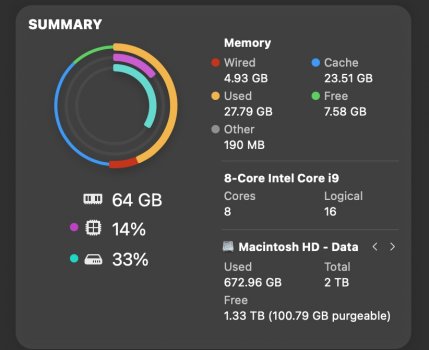I really didn't want to buy the recently announced Mac Mini.
I had hoped a refresh of the Intel version was around the corner and that there would be a pro model of the Mini introduced this year that allowed more than 16GB ram. That doesn't look like it's going to happen in 2021.
So, I caved in and pre-ordered myself a 16GB with 1TB drive. It arrives in two weeks.
For most people, 16GB would be fine. Me, I use computers differently than most. I have over two dozen apps open at all times, mostly in the background for instant access and information. I am attaching a screenshot of how memory is currently being used on my 64GB 16" MBP and you can see, I use a lot of it.
How does 16GB fare on a M1? Is it basically the same as Intel or is there better memory management that makes 16GB the new 32GB (for example)?

I had hoped a refresh of the Intel version was around the corner and that there would be a pro model of the Mini introduced this year that allowed more than 16GB ram. That doesn't look like it's going to happen in 2021.
So, I caved in and pre-ordered myself a 16GB with 1TB drive. It arrives in two weeks.
For most people, 16GB would be fine. Me, I use computers differently than most. I have over two dozen apps open at all times, mostly in the background for instant access and information. I am attaching a screenshot of how memory is currently being used on my 64GB 16" MBP and you can see, I use a lot of it.
How does 16GB fare on a M1? Is it basically the same as Intel or is there better memory management that makes 16GB the new 32GB (for example)?


